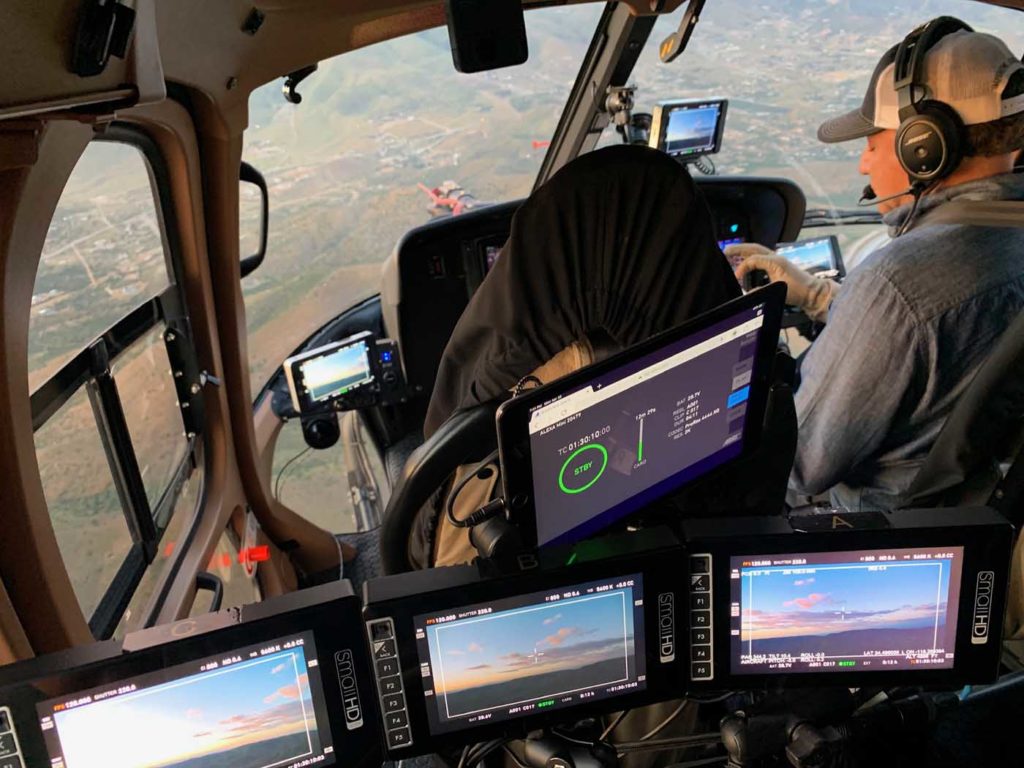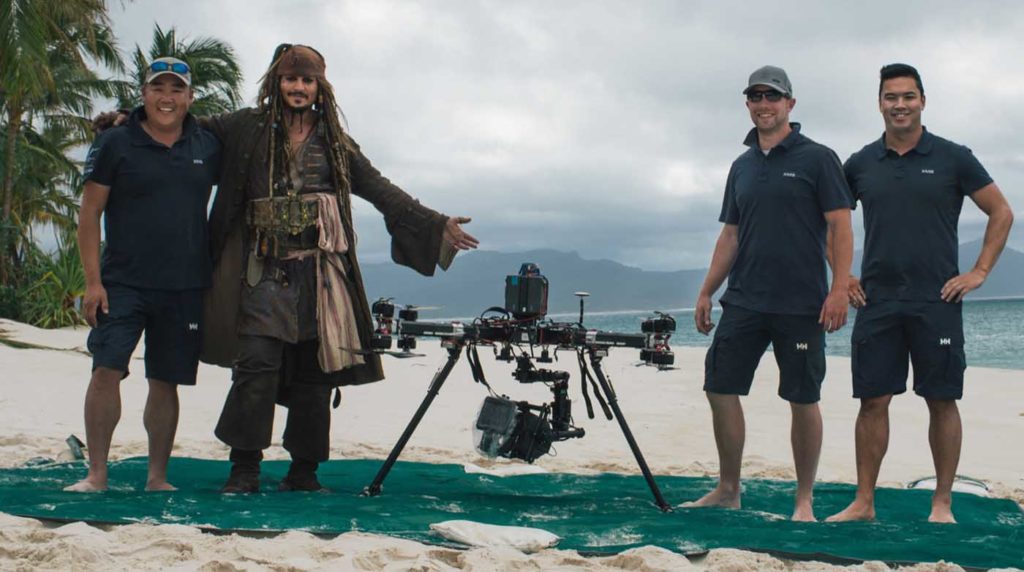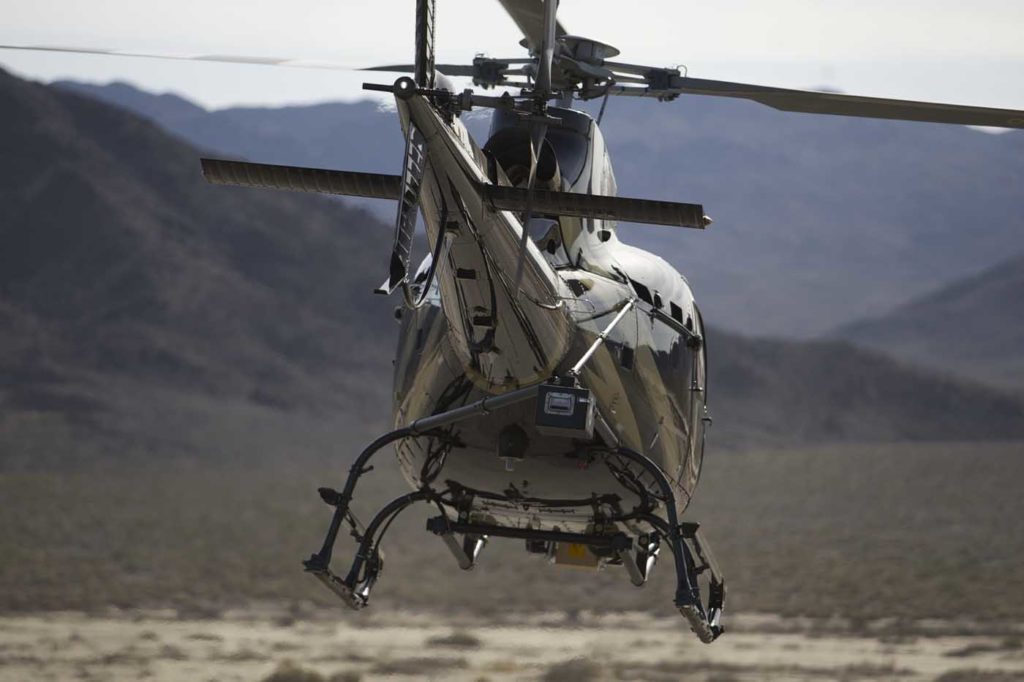Talk to Stephen Oh about the use of drones or helicopters on a film set, and the passion he has for the work he does — and the new ways his aircraft are allowing directors to tell stories — is quickly apparent. A film is a painting, directors are artists, and drones and helicopters are paintbrushes.
“Each of these tools, whether it’s an [Airbus AS350] B3, or an [AS]355 TwinStar, they’re all different paintbrushes,” said Oh. “We have a vast array of drones, and they all do a different job. We’ve even got a fixed-wing fully-customized jet, and we have a camera on the nose of that that travels at 450 miles per hour, shooting other jet planes. So every one of these assets, you can just treat as different tools for the artist to draw his painting.”

Oh is co-founder and CEO of XM2, which has become one of the world’s leading manufacturers and operators of drones for aerial filming. The company has pioneered new techniques for the use of drones in film, clocking up notable credits including Pirates of the Caribbean: Dead Men Tell No Tales, Aquaman, Star Wars: The Rise of Skywalker, and the upcoming James Bond film, No Time to Die. Earlier this year, Oh also became head of XM2 PURSUIT — a new collaboration between XM2 and Pursuit Aviation. Pursuit, an operator of fixed- and rotary-wing aircraft, has quietly but quickly established itself as a major presence in Hollywood, both behind and in front of the camera. Its credits include Thor, Dunkirk, and Westworld.
The idea behind the collaboration between XM2 and Pursuit is to offer film studios a one-stop-shop for their on-set aviation needs. One toolkit for all the paintbrushes needed for any painting an artist can conceive.

The two companies have a combined workforce of more than 30 people in offices around the globe.
“There’s a lot of common ground,” said Oh. “We all work with things that fly, especially with rotary- rather than fixed-wing, so it’s all rotor based, and we all do VTOL work.”
The roots of the partnership can be traced back to XM2’s arrival in Los Angeles, California. When Oh was looking at potential offices for his company, he introduced himself to his neighbors — including Pursuit Aviation. Finding out just how much the two companies had in common, they soon agreed to open a joint office in the U.K. at Pinewood Studios, just outside London. “One thing led to another, and here we are today in one collaboration,” said Oh. The move was made official shortly before the Covid-19 pandemic struck, pausing production around the world.
The company’s TwinStar was in France at the time, having recently wrapped up production on the new Christopher Nolan movie, Tenet. The aircraft needed to be ferried back to London, so Oh decided to take the opportunity to take a detour and extend the ferry flight back, capturing once-in-a-lifetime aerial footage of some of Europe’s busiest cities in lockdown.
“We wanted to capture something that’s never happened before, as an archival piece,” said Oh. “It was spooky. There were empty cities; [there was] no one in the places where it should have been very, very busy. It was eerie — and we captured it all.”
A multimedia background
XM2 was established over 20 years ago as a multimedia advertising agency (the “XM2” representing “eXtreme MultiMedia”), but made the move into drone manufacturing and operations about seven years ago. It may not seem like a natural step, but the focus on drones was a straightforward evolution for company founders Oh, Aidan Kelly, and Luke Annells, combining their various backgrounds in remote control [RC] aircraft construction/piloting, film production/cinematography, and engineering.
“I used to be a producer, doing of lots of corporate movies and TV commercials, but my hobby and my passion was flying remote controlled aircraft, especially helicopters,” said Oh.
About two meters long and capable of speeds of over 90 miles per hour (150 kilometers per hour), these helicopters were no toys. And, about 10 years ago, he began experimenting with them, adding cameras to see what sort of shots he might be able to achieve. Shortly afterwards, the first drones hit the market.
“When the drones came out, they were very small, so we started developing our own drones — big ones — to be able to carry big camera systems,” said Oh.
It was a major investment in what was then a relatively nascent technology, but the founders’ backgrounds made it a manageable step.
“We used to build these helicopters ourselves, so making the first iterations of the [drone] drawings wasn’t as bad as it would have been for someone who had no idea,” he said.
Aaron Corera is one of the drone pilots at XM2, but his primary role is in certification — ensuring the company has the correct licenses and permissions to fly in whichever country a project takes it to.
He said the company’s experiences on-set drive the research and development of new aircraft back at the office, whether it’s a custom-built aircraft or a unique way of carrying a camera.
“We’ve carried 35-millimeter film cameras, 360-VR cameras, and quite often they’ll be payloads that haven’t been put on a drone before,” said Corera. “Our engineers will do the design of whatever part they might need, do the machining of it in-house as well, and then go and do the testing. And quite often they’ll be the same people who are out on the job, so they have that kind of deep understanding of how it all works because they’re the ones that have put it together.”

Drone OEM & operator
XM2’s office in Melbourne, Australia, is its manufacturing base, containing a CNC machine and everything required to design and build a new drone. Its drone fleet includes the Tango II, Sierra, Inspire 2, Galaxy 950, and Enterprise. All have different functions on a movie set.
“Our Tango is our go-to device,” said Oh. “It’s very fast and it’s very accurate. Our Sierra, for example, is our heavy-lift drone. It carries three cameras, all very big systems, and does all the photogrammetry [capturing vast amounts of data and imagery to create 3D renderings].”
Oh explained that one of the current trends on movie sets is to use walls of LED panels behind actors instead of a green screen — and this is where the content shot by the Sierra comes in. The panels display this pre-shot video to create the illusion that the actors are walking through a desert, for example, or in a jungle in Thailand. The video is shot at such a high resolution that it’s impossible to tell the difference.

The Sierra was also used to help create one of the more memorable chase scenes in The Rise of Skywalker, as Rey (one of the film’s central characters) is pursued by stormtroopers through a desert landscape that is punctuated with jagged rocky outcrops.
“We shot a lot of the VFX [visual effects] plates for that sequence,” said Corera. “We did a lot of the photogrammetry in lidar that kind of builds a digital 3D model that they can then pull into post production, build their digital set, and manipulate it in a way that they can’t do in real life.”
The project that first put XM2 on Hollywood’s map was the most recent Pirates of the Caribbean movie, said Oh.
“What we brought to the table — and we were showing to the world on a major scale — was a new paintbrush, and how this paintbrush could be used,” he said. “We weren’t just using our drones for big high wide [shots] and so forth, were using them very close-up, to be intimate with the subject in very delicate operations. [We showed that] it’s not just for establishes or closes, but it can be used for lots of parts throughout the movie.”
A passion for flight
The other half of the XM2 PURSUIT collaboration — Pursuit Aviation — was founded in 2015 with the goal of becoming one of the leaders of aerial cinematography, with a particular focus on the motion picture world.
The driving force behind Pursuit is Dan Friedkin, the company’s founder and CEO of the Friedkin Group — a diverse consortium of businesses and investments in the entertainment, automotive, hospitality, sports and adventure industries.

Aviation has been one of Friedkin’s passions since childhood, and he has subsequently built one of the largest private collections of warbirds in the world. The film industry has become one of the outlets for his passion, with Friedkin establishing a successful career as a stunt pilot and aerial coordinator on various blockbuster productions. (He piloted one of the one of the Spitfires in the movie Dunkirk, and was at the controls for the noteworthy scene at the end of the film when a Spitfire lands on the beach having run out of fuel.)
“He’s an avid aviator, and that’s really where the heart of the business is, is his passion for aviation,” said Allie Mount, who looks after operations for Pursuit. “He has a vast collection of aircraft and he flies every single one of them.”
Available for the company’s use is a rotary-wing fleet that includes five Airbus H125 and AS350 B3 AStars, an Airbus AS355 TwinStar, an Aérospatiale Gazelle, and a Robinson R44.
The TwinStar is typically used for shoots that require flight over downtown populous areas due to its twin-engine redundancy, while the more powerful AStar is preferred in most other environments.
The maintenance of the company’s aircraft is performed by third parties, but Pursuit does have a director of maintenance who tracks the various inspections that are required.
Breaking into the movie production world “hasn’t been easy,” said Mount. “It’s highly competitive. There’s a small portion of operators who have the largest percentage of most of the jobs. Filmmakers use one vendor, and then that’s the vendor that they know, and then that’s just who they go to.”
That Pursuit has been able to establish itself so quickly is thanks to Friedkin’s contacts in the movie business and XM2’s involvement, she said.
Friedkin heads up the pilot department alongside John Tamburro — a vastly experienced aerial filming pilot, who has logged over 7,500 hours flying in films, TV shows and commercials.
“In our line of work, the skillset list is long and only comes with years of experience,” said Tamburro. “To be a great film pilot you need to know filmmaking, you need to know timing and lighting, you need to know how to multitask in the aircraft while talking to the director, camera operator, ground crew, air traffic control — the list goes on and there are a lot of moving parts. Your director can tell you what shot they want, but in the end, it is up to the pilot and camera operator to make the magic happen… and when it does, it’s exhilarating.”
Mixing drones & helicopters
At the end of August, Oh and Corera were in London shooting an upcoming major blockbuster. The project is particularly noteworthy for the pair as it’s the first project for XM2 PURSUIT since the collaboration was made official earlier this year, and it will be providing all drones and helicopters for the entire shoot.
While drones and helicopters aren’t often working together, they are sometimes both required at the same time, and doing so requires a lot of coordination, said Oh. Boundaries are set, either laterally or by altitude; communication between drone and aircraft is constant; and the use of observers adds another level of safety.
“It all comes down to experience,” said Oh. “Whether it’s a drone pilot or a helicopter pilot; an experienced pilot, with a lot of hours under their belt, knows what to do, what to look out for, and they know not to be complacent.”
And yes, drone pilots, not drone operators. “We call the drone pilots ‘pilots,’ because they need to, anywhere they operate, get under either CAA [Civil Aviation Authority] or FAA [Federal Aviation Administration] or whatever aviation authority protocols to actually fly,” said Oh. “And there’s a lot of responsibility in that flight.”
The rules and regulations governing what can and can’t be done with a drone — and even how large a drone can be — also vary by country. It’s another complicating factor that requires an experienced hand to navigate.
The inherent need for such familiarity with drone operations is the reason the company doesn’t train up drone pilots, “because it’s going to take five/10 years for them to get enough experience,” said Oh.
“What they need to learn is on-set experience, and that’s a completely different thing,” he added. “We start from the ground up. They come to the set and they learn the environment. It’s about peer pressure control as well. If a big-name director or producer says to do something, and it’s not something that should be done, you need to know how to say, “No,” or to say, “We won’t do it this way, we’ll do it this way.”
Looking ahead, further growth is on the horizon for XM2 PURSUIT, and Oh said he already knows the location of the company’s next three offices.
“The hardest thing about growing the business is finding the right people,” he said. “Finding a location for an office, that’s easy. . . . [The challenge] is finding people that you can trust; people that can learn very quickly.”
It’s the people that are the secret to XM2’s success to date, said Oh, with all of them driven by a passion for the industry and a desire to excel.
“If you’re going to do something, you’ve got to do it properly and you put all your energy into it,” he said. “We don’t want to be second best. I think the passion and that energy is what helps us propel and be at the pointy end of what it is that we’re doing. It’s just personal satisfaction, really — that’s what we’re striving for.”










